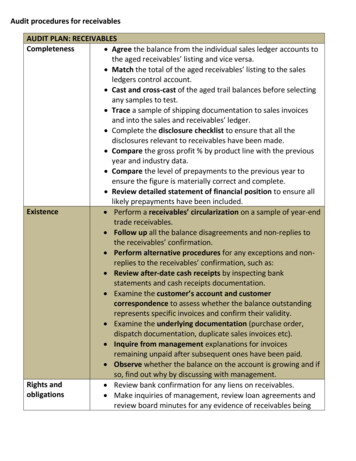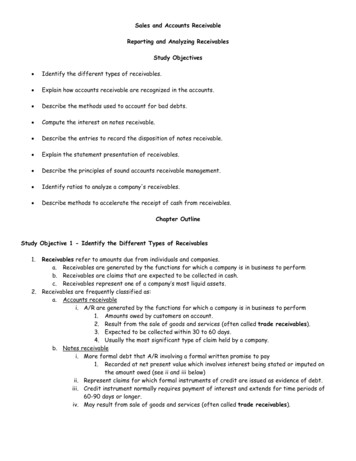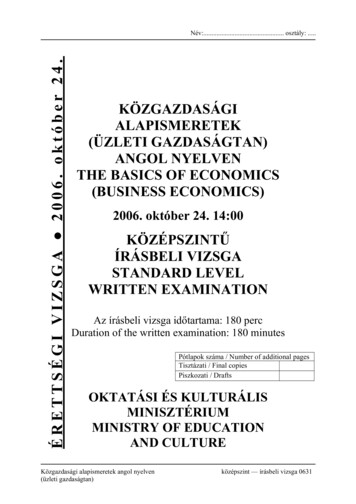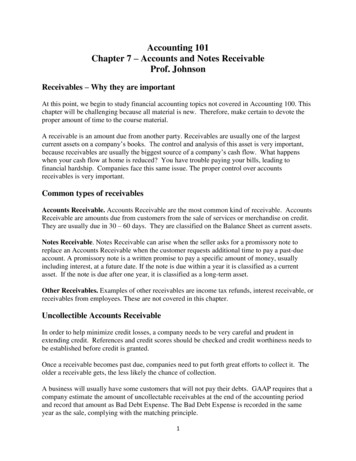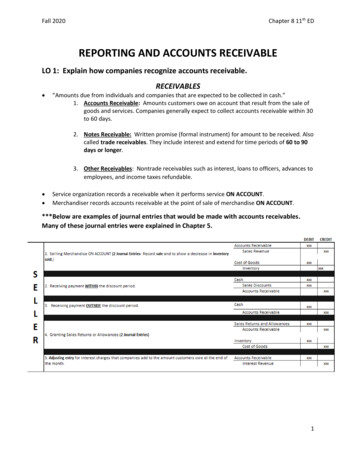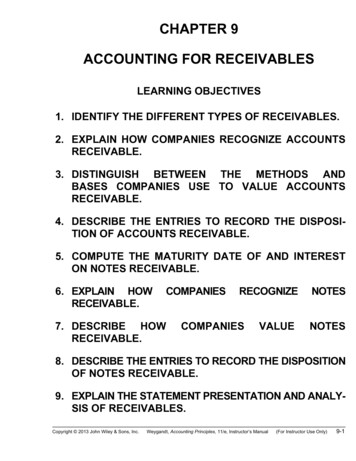
Transcription
CHAPTER 9ACCOUNTING FOR RECEIVABLESLEARNING OBJECTIVES1. IDENTIFY THE DIFFERENT TYPES OF RECEIVABLES.2. EXPLAIN HOW COMPANIES RECOGNIZE ACCOUNTSRECEIVABLE.3. DISTINGUISH BETWEEN THE METHODS ANDBASES COMPANIES USE TO VALUE ACCOUNTSRECEIVABLE.4. DESCRIBE THE ENTRIES TO RECORD THE DISPOSITION OF ACCOUNTS RECEIVABLE.5. COMPUTE THE MATURITY DATE OF AND INTERESTON NOTES RECEIVABLE.6. EXPLAIN HOWRECEIVABLE.COMPANIES7. DESCRIBE HOWRECEIVABLE.RECOGNIZECOMPANIESVALUENOTESNOTES8. DESCRIBE THE ENTRIES TO RECORD THE DISPOSITIONOF NOTES RECEIVABLE.9. EXPLAIN THE STATEMENT PRESENTATION AND ANALYSIS OF RECEIVABLES.Copyright 2013 John Wiley & Sons, Inc.Weygandt, Accounting Principles, 11/e, Instructor’s Manual(For Instructor Use Only)9-1
CHAPTER REVIEWTypes of Receivables1.2.(L.O. 1) Receivables are claims that are expected to be collected in cash. Receivables areusually classified as: (a) accounts receivable, (b) notes receivable, and (c) other receivables.Accounts receivable are amounts customers owe on account. Notes receivable are a writtenpromise (as evidenced by a formal instrument) for amounts to be received. And other receivablesinclude nontrade receivables such as interest receivable, loans to company officers, advances toemployees, and income taxes refundable.Recognizing Accounts Receivable3.(L.O. 2) When a business sells merchandise to a customer on credit, Accounts Receivable isdebited and Sales Revenue is credited.4.If a payment is received by a customer within the discount period, the following entry is made:Cash .Sales Discounts .Accounts Receivable .XXXXXXXXXValuing Accounts Receivable5.(L.O. 3) Companies record credit losses as debits to Bad Debt Expense (or UncollectibleAccounts Expense). Such losses are considered to be a normal and necessary risk of doingbusiness. Two methods are used in accounting for uncollectible accounts: (a) the direct write-offmethod and (b) the allowance method.Direct Write-off Method for Uncollectible Accounts6.Under the direct write-off method, bad debt losses are not anticipated and no allowance accountis used.a. No entries are made for bad debts until an account is determined to be uncollectible at whichtime the loss is charged to Bad Debt Expense.b. This method makes no attempt to match bad debt expense to sales revenue in the incomestatement or to show the cash realizable value of the accounts receivable in the balance sheet.c. This method is not acceptable for financial reporting purposes, unless bad debt losses areinsignificant.7.The allowance method is required when bad debts are material in amount. Its essential features are:a. Uncollectible accounts are estimated and the expense for the uncollectible accounts ismatched against sales revenue in the same accounting period in which the sales occurred.b. Estimated uncollectibles are debited to Bad Debt Expense and credited to Allowance forDoubtful Accounts through an adjusting entry at the end of each period.c. Actual uncollectibles are debited to Allowance for Doubtful Accounts and credited to AccountsReceivable at the time a specific account is written off.8.When there is a recovery of an account that has been written off as uncollectible, it is necessary to:a. reverse the entry made when the account was written off, andb. record the collection in the usual manner.9.There are two bases that are used to determine the amount of expected uncollectibles. One is thepercentage-of-sales basis, and the other is the percentage-of-receivables basis.9-2Copyright 2013 John Wiley & Sons, Inc.Weygandt, Accounting Principles, 11/e, Instructor’s Manual(For Instructor Use Only)
Percentage-of-Sales Basis10.Under the percentage-of-sales basis,a. Management establishes a percentage relationship between the amount of credit sales andexpected losses from uncollectible accounts.b. The expected bad debt losses are determined by applying the percentage to the sales baseof the current period.c. This basis better matches expenses with revenues.Percentage-of-Receivables Basis11.Under the percentage-of-receivables basis,a. The balance in the allowance account is derived from an analysis of individual customeraccounts. The analysis is often called aging the accounts receivable.b. The amount of the adjusting entry is the difference between the required balance and theexisting balance in the allowance account.c. This basis produces the better estimate of cash realizable value of the accounts receivable.Disposing Accounts Receivable12.(L.O. 4) In order to accelerate the receipt of cash from receivables, owners frequently (1) sell toa factor such as a finance company or bank, or (2) make credit card sales.13.A factor buys receivables from businesses for a fee and then collects the payments directly fromthe customers. The entry for a sale to a factor is:Cash .Service Charge Expense.Accounts Receivable .14.XXXXXXXXXCredit cards are frequently used by retailers because the retailer does not have to be concernedwith the customer’s credit history and the retailer can receive cash more quickly from the creditcard issuer. However, the credit card issuer usually receives a fee of from 2–6% of the invoiceprice from the retailer.Notes Receivable15.(L.O. 5) A promissory note is a written promise to pay a specified amount of money on demandor at a definite time. The party making the promise is called the maker; the party to whom paymentis made is called the payee.16.When the life of a note is expressed in terms of months, the due date is found by counting themonths from the date of issue. When the due date is stated in terms of days, it is necessary tocount the days. In counting days, the date of issue is omitted but the due date is included.17.The basic formula for computing interest on an interest bearing note is:Face Valueof NoteCopyright 2013 John Wiley & Sons, Inc.AnnualX InterestRateTimein TermsXof OneYear InterestWeygandt, Accounting Principles, 11/e, Instructor’s Manual(For Instructor Use Only)9-3
Recognizing Notes Receivable18.(L.O. 6) Entries for notes receivable are required when the note is received and at maturity. Toillustrate, assume that on June 1, 2014, Raider Company receives a 2,000, 3-month, 12% notereceivable from Paul Revere in settlement of an open account. The entry is:June 1Notes Receivable .Accounts Receivable .2,0002,000Valuing Notes Receivable19.(L.O. 7) Like accounts receivable, short-term notes receivable are reported at their cash (net)realizable value and an Allowance for Doubtful Accounts is used.Disposing of Notes Receivable20.(L.O. 8) On September 1, the maturity date, Paul Revere honors the note by paying the faceamount, 2,000 plus interest of 60 ( 2,000 X 12% X 3/12). Assuming that interest has not beenaccrued, the entry is:Sept. 1 Cash .Notes Receivable .Interest Revenue .2,0602,00060Statement Presentation and Analysis21.(L.O. 9) In the balance sheet, short-term receivables are reported within the current assetssection below short-term investments. Both the gross amount of receivables and the allowance fordoubtful accounts should be reported. In a multiple-step income statement, Bad Debt Expenseand Service Charge Expense are reported as selling expenses in the operating expenses section.22.The accounts receivable turnover is computed by dividing net credit sales (net sales less cashsales) by the average net accounts receivable during the year. The average collection period, avariant of the accounts receivable turnover, is computed by dividing the turnover ratio into 365days. The average collection period should not greatly exceed the credit term period.9-4Copyright 2013 John Wiley & Sons, Inc.Weygandt, Accounting Principles, 11/e, Instructor’s Manual(For Instructor Use Only)
LECTURE OUTLINEA.Types of Receivables.1. Receivables refer to amounts due from individuals and companies thatare expected to be collected in cash.2. Receivables are classified as:B.a.Accounts receivable are amounts customers owe on account.Companies generally expect to collect these receivables within30 to 60 days.b.Notes receivable are a written promise (as evidenced by a formalinstrument) for amounts to be received. A note normally requires thecollection of interest and extends for time periods of 60 to 90 days orlonger.c.Other receivables include nontrade receivables such as interest receivable, loans to company officers, advances to employees, and incometaxes refundable.Recognizing Accounts Receivable.1. Accounts receivable are recognized when merchandise is sold on account,as explained in Chapter 5.2. Recognizing accounts receivable also occurs when a company sells merchandise and a customer uses the company’s own credit card.a.Credit card sales result in a debit to Accounts Receivable and a creditto Sales Revenue.b.If customers fail to pay within a specified period (usually 30 days), theseller adds interest. The interest is debited to Accounts Receivable andcredited to Interest Revenue.Copyright 2013 John Wiley & Sons, Inc.Weygandt, Accounting Principles, 11/e, Instructor’s Manual(For Instructor Use Only)9-5
C.Valuing Accounts Receivable.1. Valuing receivables involves reporting receivables at their cash (net) realizable value. Cash (net) realizable value is the net amount expected to bereceived in cash.2. Uncollectible Accounts Receivable.a.Credit losses are a normal and necessary risk of doing business ona credit basis. Credit losses may be recognized under the allowancemethod or by the direct write-off method.b.GAAP requires the allowance method for financial reporting purposeswhen bad debts are material in amount. Under this method:(1) Companies estimate uncollectible accounts receivable and matchthis estimate expense against revenues in the sameaccounting period in which they record the revenues.(2) Companies debit estimated uncollectibles to Bad Debt Expenseand credit them to Allowance for Doubtful Accounts (a contraasset account) through an adjusting entry at the end of eachperiod.(3) When companies write off a specific account, they debit actualuncollectibles to Allowance for Doubtful Accounts and credit thatamount to Accounts Receivable.3. Occasionally, a company collects from a customer after it has written offthe account as uncollectible. The company9-6a.Reverses the entry made in writing off the account to reinstate thecustomer’s account.b.Journalizes the collection in the usual manner.Copyright 2013 John Wiley & Sons, Inc.Weygandt, Accounting Principles, 11/e, Instructor’s Manual(For Instructor Use Only)
4. Two bases are used to determine the amount of the expected uncollectibles:TEACHING TIPEmphasize the income statement point of view—the matching of bad debtexpense with revenues in the same period.a.Under the percentage-of-sales basis, management estimates whatpercentage of credit sales will be uncollectible. This percentage isbased on past experience and anticipated credit policy, and is appliedeither to total credit sales or net credit sales of the current year.(1) This basis of estimating uncollectibles emphasizes the matchingof expenses with revenues (income statement viewpoint).(2) When the company makes the adjusting entry, it disregards theexisting balance in Allowance for Doubtful Accounts.b.Under the percentage-of-receivables basis, management estimateswhat percentage of receivables will result in losses from uncollectibleaccounts. The company prepares an aging schedule, in which it classifies customer balances by the length of time they have been unpaid.TEACHING TIPEmphasize an aging schedule is provided to arrive at the required balance for theallowance account. Emphasize the balance sheet point of view—the determination ofthe net realizable value of the receivables.(1) This method normally results in the better approximation of cashrealizable value (balance sheet viewpoint).(2) An aging schedule is used to determine the required balance inthe allowance account at the balance sheet date.(3) The amount of the bad debt expense adjusting entry is the difference between the required balance and the existing balance inthe allowance account.Copyright 2013 John Wiley & Sons, Inc.Weygandt, Accounting Principles, 11/e, Instructor’s Manual(For Instructor Use Only)9-7
5. The direct write-off method may be used for financial reporting purposesonly when bad debts are insignificant. Under this method:D.a.Bad debt losses are not estimated and an allowance account is notused.b.Bad debt losses are debited to Bad Debt Expense when they aredetermined to be uncollectible.c.This method does not attempt to match bad debt expense with salesrevenues or to show accounts receivable in the balance sheet at theamount the company actually expects to receive.Disposing of Accounts Receivable.1. In the normal course of events, companies collect accounts receivable incash and remove receivables from the books.2. Companies frequently sell their receivables to another company forcash, which shortens the cash-to-cash operating cycle.3. A sale may be made to a factor which is a finance company or bank thatbuys receivables from businesses and then collects the payments directlyfrom the customers.4. A credit card sale occurs when a company accepts national credit cards,such as Visa, Mastercard, and American Express.9-8a.A retailer’s acceptance of a national credit card is another form ofselling (factoring) the receivable.b.The retailer generally considers sales from the use of national creditcard sales as cash sales. The retailer must pay to the bank thatissues the card a fee of 2 to 6% for processing the transactions.Copyright 2013 John Wiley & Sons, Inc.Weygandt, Accounting Principles, 11/e, Instructor’s Manual(For Instructor Use Only)
ACCOUNTING ACROSS THE ORGANIZATIONAssume you use a Visa card to purchase some new ties at Nordstrom. Visa actsas the clearing agent for the transaction and transfers funds from the bank thatissued your Visa card to Nordstrom’s bank account.If Nordstrom prepares a bank reconciliation monthly and some credit card saleshave not been processed by the bank, how should Nordstrom treat thesetransactions on its reconciliation?Answer: Nordstrom would treat the credit card receipts as deposits in transit. Ithas already recorded the receipts as cash. Its bank will increaseNordstrom’s cash account when it receives the receipts.E.Notes Receivable.1. A promissory note is a written promise to pay a specified amount of moneyon demand or at a definite time. Notes receivable give the payee a strongerlegal claim to assets than accounts receivable. Promissory notes maybe used:a.When individuals and companies lend or borrow money.b.When the amount of the transaction and the credit period exceednormal limits.c.In settlement of accounts receivable.2. Determining the maturity date. When the life of a note is expressed interms of months, you find the date when it matures by counting the monthsfrom the date of issue. When the due date is stated in terms of days, youneed to count the exact number of days to determine the maturity date.In counting, omit the date the note is issued but include the due date.Copyright 2013 John Wiley & Sons, Inc.Weygandt, Accounting Principles, 11/e, Instructor’s Manual(For Instructor Use Only)9-9
3. Computing interest. The formula for computing interest is face value ofnote times annual interest rate times time in terms of one year. For anote stated in months, a fraction of the year is used; when a note is stated indays, time factor is the number of days in the note divided by 360.4. Recognizing notes receivable occurs when the note is received. Thecompany records the note receivable at its face value by debiting NotesReceivable and crediting Accounts Receivable.5. Valuing short-term notes receivable involves reporting notes receivable attheir cash (net) realizable value.a.The notes receivable allowance account is Allowance for DoubtfulAccounts.b.The estimations involved in determining cash realizable value andin recording bad debt expense and the related allowance aresimilar.6. Disposing of notes receivable involves the honoring (paying) or dishonoring(not paying) of the note at maturity.9-10a.A note is honored when its maker pays it in full at its maturity date.If interest has been accrued prior to maturity, Interest Receivable iscredited for the accrued interest at maturity.b.A dishonored (defaulted) note is a note that is not paid in full atmaturity. The entry to record the dishonor of a note depends onwhether the payee expects eventual collection. If the debtor isexpected to pay, Accounts Receivable is debited for the face valueof the note plus accrued interest. If there is no hope of collection, thepayee would write off the face value of the note by debitingAllowance for Doubtful Accounts.Copyright 2013 John Wiley & Sons, Inc.Weygandt, Accounting Principles, 11/e, Instructor’s Manual(For Instructor Use Only)
F.Statement Presentation and Analysis.1. Companies should identify in the balance sheet or in the notes to thefinancial statements each of the major types of receivables.2. Short-term receivables appear in the current assets section of the balancesheet. Companies report both the gross amount of receivables and theallowance for doubtful accounts.3. In a multiple-step income statement, companies report bad debt expense and service charge expense as selling expenses in the operatingexpenses section. Interest revenue appears under “Other revenues andgains” in the nonoperating activities section.4. Investors and managers evaluate accounts receivable for liquidity bycomputing the accounts receivable turnover and an average collectionperiod.a.The accounts receivable turnover is computed by dividing net creditsales by the average net accounts receivable during the year. Thisratio measures the number of times, on average, the companycollects accounts receivable during the period.b.The average collection period is computed by dividing the accountsreceivable turnover into 365 days. Companies frequently use theaverage collection period to assess the effectiveness of a company’scredit and collection policies.Copyright 2013 John Wiley & Sons, Inc.Weygandt, Accounting Principles, 11/e, Instructor’s Manual(For Instructor Use Only)9-11
A Look at IFRSThe basic accounting and reporting issues related to recognition and measurementof receivables, such as the use of allowance accounts, how to record discounts,use of the allowance method to account for bad debts, and factoring, areessentially the same between IFRS and GAAP.KEY POINTSIFRS requires that loans and receivables be accounted for at amortized cost,adjusted for allowances for doubtful accounts. IFRS sometimes refers tothese allowances as provisions.Although IFRS implies that receivables with different characteristics shouldbe reported separately, there is no standard that mandates this segregation.The FASB and IASB have worked to implement fair value measurement (theamount they currently could be sold for) for financial instruments. BothBoards have faced bitter opposition from various factions. As a consequence, the Boards have adopted a piecemeal approach. The first step isdisclosure of fair value information in the notes. The second step is the fairvalue option, which permits, but does not require, companies to record sometypes of financial instruments at fair values in the financial statements.IFRS requires a two-tiered approach to test whether the value of loans andreceivables are impaired. First, a company should look at specific loansand receivables to determine whether they are impaired. Then, the loansand receivables as a group should be evaluated for impairment. GAAPdoes not prescribe a similar two-tiered approach.IFRS and GAAP differ in the criteria used to determine how to record afactoring transaction. IFRS uses a combination approach focused on risksand rewards and loss of control. GAAP uses loss of control as the primarycriterion. In addition, IFRS permits partial derecognition of receivables;GAAP does not.9-12Copyright 2013 John Wiley & Sons, Inc.Weygandt, Accounting Principles, 11/e, Instructor’s Manual(For Instructor Use Only)
LOOKING TO THE FUTUREIt appears likely that the question of recording fair values for financial instrumentswill continue to be an important issue to resolve as the Boards work towardconvergence. Both the IASB and the FASB have indicated that they believe thatfinancial statements would be more transparent and understandable ifcompanies recorded and reported all financial instruments at fair value. Thatsaid, in IFRS 9, which was issued in 2009, the IASB created a split model, wheresome financial instruments are recorded at fair value, but other financial assets,such as loans and receivables, can be accounted for at amortized cost if certaincriteria are met. Critics say that this can result in two companies with identicalsecurities accounting for those securities in different ways. A proposal by theFASB would require that nearly all financial instruments, including loans andreceivables, be accounted for at fair value. It has been suggested that IFRS 9 willlikely be changed or replaced as the FASB and IASB continue to deliberate thebest treatment for financial instruments. In fact, one past member of the IASBsaid that companies should ignore IFRS 9 and continue to report under the oldstandard. In his opinion, it was extremely likely that it would be changed before2013, the mandatory adoption date of the standard.Copyright 2013 John Wiley & Sons, Inc.Weygandt, Accounting Principles, 11/e, Instructor’s Manual(For Instructor Use Only)9-13
20 MINUTE QUIZCircle the correct answer.True/False1.Receivables are classified as accounts, notes, or other.True2.Financing charges added to a customer’s credit card balance with a retailer are recordedas a debit to Accounts Receivable and a credit to Interest Revenue.True3.FalseShort-term receivables are reported in the balance sheet immediately below cash.True9-14FalseThe principal amount of a 9%, 3-year, note receivable is 300,000 and is dated January 1,2014. The interest revenue to be recognized on December 31, 2014, is 9,000.True10.FalseThe maturity value of a 5,000 note is 5,300. If 180 of the interest has been accruedprior to maturity, the entry to record the honoring of the note at maturity should includea credit to Interest Revenue for 120.True9.FalseThe interest due at maturity of a two-month, 8%, 800 note is computed by multiplying 800X.08 X 2/12.True8.FalseThe maturity date of a 60-day note dated December 1 is January 31.True7.FalseSale of receivables to a factor may result in a debit to Service Charge Expense at the timeof sale.True6.FalseAn aging schedule shows a required balance in Allowance for Doubtful Accounts of 8,600.If there is a credit balance in the allowance account of 2,000 prior to adjustment, theadjustment amount is 6,600.True5.FalseThe allowance method for uncollectible accounts violates the expense recognitionprinciple.True4.FalseFalseCopyright 2013 John Wiley & Sons, Inc.Weygandt, Accounting Principles, 11/e, Instructor’s Manual(For Instructor Use Only)
Multiple Choice1.The sale of merchandise by a company on its own credit card may result in aa. debit to Service Charge Expense.b. debit to Interest Expense.c. credit to Interest Revenue.d. credit to Cash.2.A company has net credit sales of 600,000 for the year and it estimates that uncollectibleaccounts will be 2% of sales. If Allowance for Doubtful Accounts has a credit balance of 1,000 prior to adjustment, its balance after adjustment will be a credit ofa. 12,000.b. 13,000.c. 11,000.d. some other amount.3.Under the allowance method, the entry to write-off an uncollectible account results ina debit toa. Bad Debt Expense and a credit to Accounts Receivable.b. Bad Debt Expense and a credit to Allowance for Doubtful Accounts.c. Allowance for Doubtful Accounts and a credit to Bad Debt Expense.d. Allowance for Doubtful Accounts and a credit to Accounts Receivable.4.A company sells 400,000 of accounts receivable to a factor for cash less a 2% servicecharge. The entry to record the sale should not include aa. debit to Interest Expense for 8,000.b. debit to Cash for 392,000.c. debit to Service Charge Expense for 8,000.d. credit to Accounts Receivable for 400,000.5.When an interest-bearing note is dishonored at maturity and ultimate collection is expected,the entry for the dishonoring, assuming no previous accrual of interest should includea. a debit to Allowance for Doubtful Accounts.b. only a credit to Notes Receivable.c. a credit to Notes Receivable and Interest Revenue.d. a credit to Notes Receivable and Interest Receivable.Copyright 2013 John Wiley & Sons, Inc.Weygandt, Accounting Principles, 11/e, Instructor’s Manual(For Instructor Use Only)9-15
ANSWERS TO .9.10.FalseTrueTrueFalseFalseMultiple Choice1.2.3.4.5.9-16c.b.d.a.c.Copyright 2013 John Wiley & Sons, Inc.Weygandt, Accounting Principles, 11/e, Instructor’s Manual(For Instructor Use Only)
Percentage-of-Receivables Basis 11. Under the percentage-of-receivables basis, a. The balance in the allowance account is derived from an analysis of individual customer accounts. The analysis is often called aging the accounts receivable. b. The amount of the adjusting entry is the difference between the required balance and the
